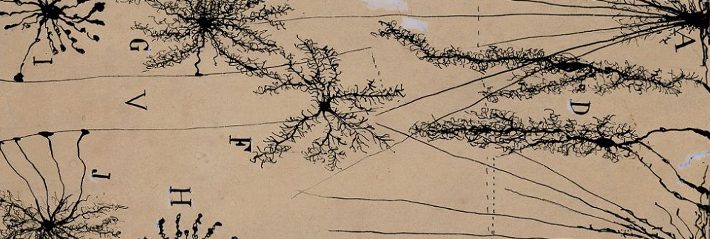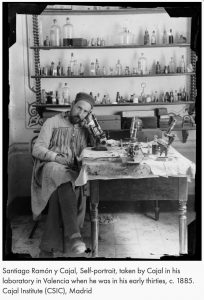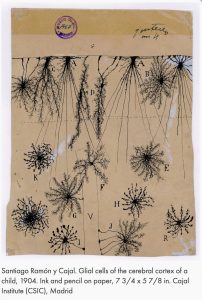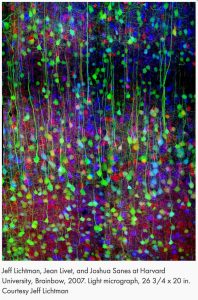On February 10th, the Student Interest Group in Neurology and Neurosurgery (SIGNN), in collaboration with Laura Ferguson and students in her Art and Anatomy class, organized an outing to experience the incredible work of neuroscientist Santiago Ramón y Cajal, on display at the Grey Art Gallery at NYU. Cajal spent his career studying the nervous system, and in the process constructed mesmerizing images that have drawn praise from art enthusiasts and scientists alike. Aside from its artistic quality, Cajal’s work has also continued to influence the work of contemporary neuroscientists and physicians. Accordingly, the exhibit also featured artwork from today’s neuroscience researchers that, while thematically similar to Cajal’s drawings, had a refreshingly modern twist.
We received some thoughtful reflections from the group about their experiences, which have been reproduced below. Enjoy!
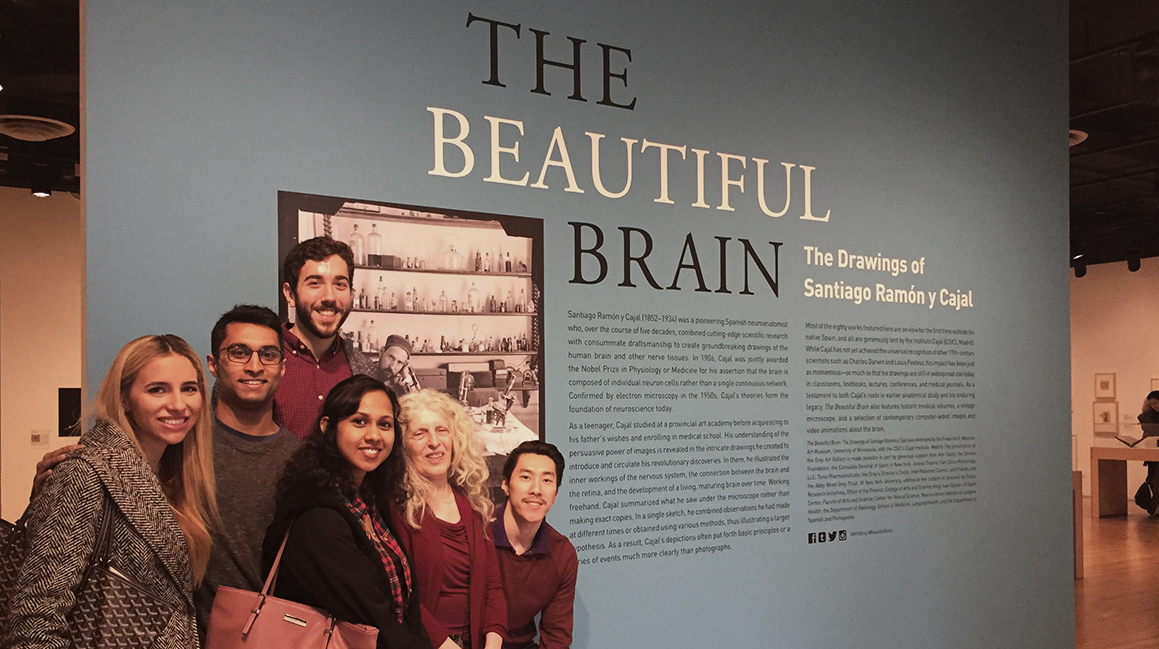 Art enthusiasts from NYU School of Medicine posing with a pensive portrait of Santiago Ramón y Cajal. From left to right: Lindsey Remark, Shawn Thomas, Rhodes Hambrick, Pournami Rajeev, Laura Ferguson, Ho Fei (Thomas) Sit. Not Pictured: Luke Moretti
Art enthusiasts from NYU School of Medicine posing with a pensive portrait of Santiago Ramón y Cajal. From left to right: Lindsey Remark, Shawn Thomas, Rhodes Hambrick, Pournami Rajeev, Laura Ferguson, Ho Fei (Thomas) Sit. Not Pictured: Luke Moretti
Like Cajal, my primary medium is drawing, and like him I view drawing as not just a means to illustrate and make knowledge visible, but rather as a key part of the process through which insight and understanding are gained. This is the basic principle of my Art & Anatomy class, where med students learn through drawing from bones and cadaver dissections, and gain a different and deeper experience of the Anatomy Lab. As artists, we use our imaginations and our creativity to enhance what we see with our eyes. It was such a pleasure for me to be at the Cajal exhibit with these students– and a crowd of other visitors – who all were clearly sharing in my sense of deep interest and fascination. Roberta Smith began her NY Times review with, “It’s not often that you look at an exhibition with the help of the very apparatus that is its subject,” and I think we all felt conscious of that– not just because we were looking at images of the brain, but at drawings, made by an artist-scientist whose own consciousness and creativity had informed his work.
-Laura Ferguson, Artist in Residence in the Master Scholars Program in Humanistic Medicine
One of the things that I liked most about the exhibit was the narrative flow to how the exhibit was arranged. Right when you walk in, you’re greeted by a pensive portrait of Cajal, along with a short bio about his life and career. He originally wanted to be an artist, but his father pushed him into becoming a physician. It’s great to see that he was still able to pursue his original passion for art in the context of an unexpected career path. It was also really interesting to see some of the modern artwork from present-day neuroscientists, which used more advanced microscope and coloring techniques to produce fascinating visuals. The trip gave me a great appreciation for how intertwined art and science can be, and how a passion for one discipline can deeply influence another, if you’re willing to have an open mind.
-Shawn Thomas, 1st year MD Student
I really appreciated the intersection of art and science in Santiago Ramón y Cajal’s incredibly detailed, beautiful drawings of the brain’s most intricate and fascinating network of cellular connections and interactions. It seems to me that his multi-disciplinary approach to studying the brain is what allowed him a unique perspective on the complex structure of its organization. This is probably what helped him develop theories and insights about the brain’s function that were beyond the technology of his time, making him the father of modern neuroscience. As someone interested in the intersection of art and science, I realized how Santiago Ramón y Cajal was able to recognize the power of this intersection, and how much you can learn and discover from observation and artistic expression.
-Lindsey Remark, 1st year MD/PhD Student
The incredible complexity of the human nervous system has variably fascinated and intimidated me ever since I first endeavored to study it as a medical student. The nigh immeasurable number of interconnections, crossovers, elegant pathways, and disparate parts working in harmonious unity to produce human thought, emotion, speech, movement, vision, and self-awareness comprise a symphony almost too perfect to comprehend. Having entered into medical education in a time in which cross-sectional imaging (computed tomography, magnetic resonance imaging) of the nervous system was possible, I had perhaps naively assumed that much of our knowledge regarding the nervous system had only emerged in the era of brain scans and functional MRI.
Having the opportunity to visit the Grey Art Gallery at NYU featuring the drawings of Santiago Ramón y Cajal was therefore an illuminating, humbling experience. His drawings of the intricate micro-anatomy of the nervous system – pyramidal cells with their thin tendrils, ascending and descending spinal cord pathways, the multidirectional myelination of oligodendrocytes – carefully crafted in the late 19th and early 20th centuries without the aid of modern imaging, served as a testament to his genius and his meticulous attention to detail. It was especially striking to me that Cajal could find such depths of patience to obsess over the tiny details of neuroanatomical connections using only dead and dying tissue. The care with which he depicts each cell, synapse, and pathway are those that one typically associates with portraiture – to depicting the beauty and wonder of the human form. And indeed, after spending a morning pondering Cajal’s genius, I realize I had a unique opportunity to experience a rendering of the human condition from the inside out – portraiture not of that readily evident, but of the system that allows for humanity to be just that: human.
-Rhodes Hambrick, 4th year MD Student

